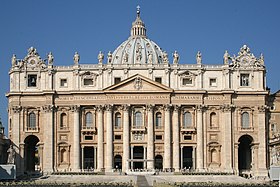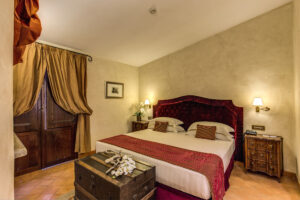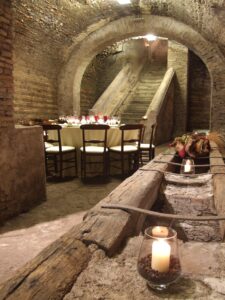 For several years now I’ve received the annual online guide from the non-profit Association Ospitalità Religiosa Italiana (Italian Religious Hospitality) (www.ospitalitareligiosa.it), headquartered at Via Molina 10 in Varese, a city in Lombardy northwest of Milan, tel. 011-39-327-3842841. Certainly of interest when Italy reopens to American tourists after Co-Vid 19, it lists some 4,000 “religious stays” with a total of some 287,000 beds in Italy. These include guesthouses, holiday houses, B&Bs, campsites, hostels, and hermitages, convents and monasteries, which open to visitors on vacation and to students.
For several years now I’ve received the annual online guide from the non-profit Association Ospitalità Religiosa Italiana (Italian Religious Hospitality) (www.ospitalitareligiosa.it), headquartered at Via Molina 10 in Varese, a city in Lombardy northwest of Milan, tel. 011-39-327-3842841. Certainly of interest when Italy reopens to American tourists after Co-Vid 19, it lists some 4,000 “religious stays” with a total of some 287,000 beds in Italy. These include guesthouses, holiday houses, B&Bs, campsites, hostels, and hermitages, convents and monasteries, which open to visitors on vacation and to students.
Of these “stays” 1,818 with 113,356 beds are administered directly by religious personnel; 1,487 with 123,985 beds belong to a religious order but are run by laypeople; 189 with 13,157 beds belong to non-profit Christian associations and 447 with 36,301 beds are run by laypeople for profit but specialize in accommodations for religious groups. Of these 817 have facilities for the disabled, 1,209 for sports activities and 1,120 for meetings. Many are particularly appropriate for families and several accept pets.
No other country, not even Spain, offers similar “religious” hospitality. They are found in all 20 regions of Italy with the largest number, some 600, logically in Latium, with many in Rome and several within walking distance to Vatican City. I can recommend Villa Santa Maria (villasantamaria@tiscali.it, 011-39-0639387388) and newly –refurbished Casa Tra Noi (www.hotelcasatranoi.it), both at the top of Via Monte del Gallo.
Gallo means rooster in Italian so Via Monte del Gallo should mean “Rooster Mountain Street” — instead I was told by a neighbor that Gallo also means “Gaul” and was an insulting way to refer to a Frenchman. In this case it refers to Charles III, Duke of Bourbon (1490-May 6, 1527). A French military leader, he was commander of the Imperial troops of the Holy Roman Emperor Charles V, during the Sack of Rome in 1527, the only time in history that the Swiss Guards saw combat. Charles who died in this combat, supposedly camped his troops here on this Monte.

Charles III, Duke of Bourbon
Other accommodations nearby that are also on O.R.I.’s website are Centro Boemo Velehrad at Via delle Fornaci 200; Emmaus Hotel at Via delle Fornaci 25; and Holiday Home Santa Maria alle Fornaci at Piazza Santa Maria delle Fornaci 27. Farther afield: Villa San Giovanni at Via del Casale di San Pio V 1 and Hotel Santa Prisca at Largo Manlio Gelsomini 25.
After Latium comes Lombardy with 381, Tuscany with 361, and Emilia Romagna with 342. Look into: Albergo Sacro Monte, Via Salvatore Bianchi 5, Varese; Holiday House Oblate Sisters of the Assumption, Borgo Pinto 5, Florence; and Hotel Palazzo Galletti Abbiosi, Via di Roma 140, Ravenna.
The Association’s multilingual (Italian, English French, Spanish, Portuguese, and German) state-of-the-art website cites them all. Each entry has a photograph and icons of all the services offered as well as a description of nearby transportation and tourist attractions. Most “stays” include Breakfast and Wi-Fi and accept credit cards. Thus you only need to make a few clicks to check out and book the “stay” that best fulfills your needs. There’s even an entry with a list of the O.R.I. “stays” that have never closed during the lockdown.
Sadly, but predictably, in mid-May, I received an alarming press release from Fabio Rocchi, the Association’s President. Its headline was: “Religious hospitality in Italy is on its knees, and this time not for prayer.” The bad news is that only half of the website’s entries (not yet specified which ones) will definitely reopen this summer if not to Americans. One in three is waiting to see how the Co-Vid 19 pandemic evolves before making a decision. About 200 have decided not to reopen in 2020 and sadly, another 100 not to reopen ever again, though of course unspecified in 2020’s list.
The entries’ economic loss is estimated to have been 5 million euro a day during the lockdown, which not only damages access to affordable tourism, but more importantly diminishes the finances of the many Church-supported schools and charitable parochial groups in Italy but also in the Third World that receive contributions from these “religious stays”.
Yet the press release is not totally pessimistic. The good news is, that in spite of their overwhelming lost income and the expenses of sanitizing their premises, all of the “religious stays” that are definitely reopening have decided not to lay off any of their employees and not to raise their prices. In fact, many have decided to lower their prices even if three-quarters of them expect to lose between 40 and 90 percent of their income in 2020.
Needless to say, it is well known that tourism is one of Italy’s main industries, the country’s petroleum. It accounts for c. 12% of Italy’s GDP and c. 13% of its total national employment. In 2019 it contributed 40 billion euros to the economy, 6% more than the year before.

Although it’s not in O.R.I.’s listings, the premises of the VOI Camilla Savelli Hotel still belong to the religious order of nuns, the Agostiniane dei Sette Dolori, but are administered by the tour operator Alpitour. It’s a four-star oasis at Via Garibaldi 27 in the pulsing heart of Trastevere. At the foot of the Janiculum Hill, it’s a ten-minute walk uphill to the Acqua Paola fountain, once part of the Emperor Trajan’s aqueduct transformed by Pope Paul V Borghese between 1608-10; the church of San Pietro in Montorio built on the site of St. Peter’s crucifixion; Bramante’s Tempietto, the model for Michelangelo’s dome of St. Peter’s Basilica; and the Spanish and American Academies. Instead five minutes downhill from the hotel is one of Rome’s most acclaimed restaurants, Antica Pesa; the Villa Farnesina, once the Roman residence of Agostino Chigi, the Sienese banker and art patron, frescoed by Raphael; the Palazzo Corsini art museum; and the church Santa Maria Trastevere on the neighborhood’s main piazza.

Camilla Savelli
The hotel owes its name to Camilla Virginia Savelli (1601-1668), the only daughter of Giovanni, the impoverished Duke of Palombara, Church official and Custodian of the Conclave, and of noblewoman Livia Orsini. Around 1621 Camilla, suppressing her religious vocation, married much older but wealthy Pietro Farnese, for financial reasons. When they had no children, deeply impressed by the religious devotion of her sister-in-law Francesca Farnese, a Clarissa, who’d founded convents in Albano, Palestrina, and Rome, Camilla decided to follow her example of a life of charity.
Thus, thanks to her husband’s generosity, Camilla bought the land at the foot of the Janiculum, and around 1642, work on her desired convent complex began with the highly esteemed architect Francesco Borromini in charge. Its purpose was to shelter young noblewomen too sickly to join other religious orders. Camilla put her heart, soul and all her economic resources into this project, but in 1655 construction stopped for lack of finances. This explains the unfinished brick façade of the church, similar in style, but without the marble facing of Borromini’s wavy façade on the Palazzo Filippini across the Tiber. Nonetheless, Camilla wrote the rules of her order, which Pope Alexander VII approved. At her death in 1668 Camilla requested to be buried in her complex’s church and left it all her inheritance.
Camilla’s complex was not the first building on this site. Below it are the remains of a 1st-century AD Roman bath, a tepidarium. Later this bath, now known as the “grotto”, probably became the warehouse of a wealthy merchant, for Trastevere was an industrial storage area for the nearby port Ripetta. Centuries later, amazingly, during World War II, the nuns successfully hid Jewish families in this grotto despite the SS headquarters directly across Via Garibaldi. Today the grotto is rentable for private parties (30 guests at most) and every year on April 21 General Manager Elena Prandelli invites guests to celebrate the city of Rome’s birthday here.

Grotto
Inaugurated in 2008 after extensive but tasteful restoration and reopened after Co-Vid 19’s lockdown on June 8, the VOI (standing for Vera Ospitalità Italiana) Donna Camilla Savelli counts 99 rooms (from 180 euros a night) and suites, once nuns’ cells, furnished primarily with antiques, but also equipped with every possible state-of-the-art convenience. Although not a guest, Woody Allen filmed scenes of “To Rome With Love” in Suite 504.
In addition to regional Italian dishes revisited served à la carte, Neapolitan Chef Emidio Gennaro Ferro, offers a seasonal tasting menu of Renaissance dishes in the restaurant, “Il Ferro e Il Fuoco”. Prandelli discovered their recipes in Rome’s historical Casanatense Library.

Chef Emidio Gennaro Ferro
Other guest perks are private access to the church, the once frescoed refectory (rentable for private events), the magnificent view over Rome from the rooftop terrace, and the peaceful Italian Renaissance-style garden with a citrus grove and 17th-century fountain. Here it’s possible to enjoy drinks, snacks, and supper. Another fountain, attributed to Borromini, decorates an inner cloister. Here the restorers uncovered the ancient tombstone of an early Christian martyr. Its inscription, uncommonly in Greek, states his name “Gordian” and that he was beheaded.
There are several VOI 5-star seaside resorts in Calabria, Puglia, Sardinia, and Sicily, not to leave out Asia and Africa, so Donna Camilla Savelli is VOI’s only urban setting until Ca’ di Dio 5 opens near the Arsenale in Venice around Easter 2021.

Lucy, what an informative article, many thanks.
Auguri,
Susanna